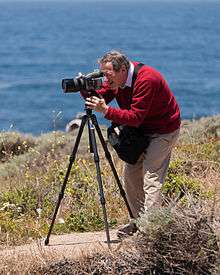Douglas Osheroff
| Douglas Osheroff | |
|---|---|
|
| |
| Born |
Douglas Dean Osheroff August 1, 1945 Aberdeen, Washington, U.S. |
| Residence | California, U.S. |
| Citizenship | United States |
| Nationality | American |
| Fields | Experimental Physics, Condensed Matter Physics |
| Institutions |
Stanford University Bell Labs |
| Alma mater | California Institute of Technology (B.S.), Cornell University (Ph.D.) |
| Doctoral advisor | David Lee |
| Known for | Discovering superfluidity in Helium-3 |
| Influences | Richard Feynman |
| Notable awards |
Nobel Prize in Physics (1996) Simon Memorial Prize (1976) Oliver E. Buckley Condensed Matter Prize (1970) |
| Spouse | Phyllis Liu-Osheroff (m. 1970 – present) |
Douglas Dean Osheroff (born August 1, 1945) is a physicist known for his work in experimental condensed matter physics, in particular for his co-discovery of superfluidity in Helium-3. For his contributions he shared the 1996 Nobel Prize in Physics along with David Lee and Robert C. Richardson.[1]
Life and work
Osheroff was born in Aberdeen, Washington. His father, William Osheroff, was the son of Jewish immigrants who left Russia. His mother, Bessie Anne (Ondov), a nurse, was the daughter of Slovak immigrants (her own father was a Lutheran minister).[2] Osheroff was confirmed in the Lutheran Church but he was given the chance to choose and decided not to attend any longer. He has stated "In some sense it seemed that lying in church is the worst place to lie. I guess at some emotional level I accept the idea of God, but I don't know how God would manifest itself."[3]
Osheroff earned his Bachelor's degree in 1967 from Caltech, where he attended lectures by Richard Feynman and did undergraduate research for Gerry Neugebauer.
Osheroff joined the Laboratory of Atomic and Solid State Physics at Cornell University as a graduate student, doing research in low-temperature physics. Together with David Lee, the head of the laboratory, and Robert C. Richardson, Osheroff used a Pomeranchuk cell to investigate the behaviour of 3He at temperatures within a few thousandths of a degree of absolute zero. They discovered unexpected effects in their measurements, which they eventually explained as phase transitions to a superfluid phase of 3He.[4][5] Lee, Richardson and Osheroff were jointly awarded the Nobel Prize in Physics in 1996 for this discovery.
Osheroff received a Ph.D. from Cornell University in 1973. He then worked at Bell Labs in Murray Hill, New Jersey for 15 years, continuing to research low-temperature phenomena in 3He. In 1987 he moved to the Departments of Physics and Applied Physics at Stanford University, where he also served as department chair from 1993-96. His research is focused on phenomena that occur at extremely low temperatures.
Osheroff was selected to serve on the Space Shuttle Columbia investigation panel, serving much the same role as Richard Feynman did on the Space Shuttle Challenger panel.
He currently serves on the board of advisors of Scientists and Engineers for America, an organization focused on promoting sound science in American government.

Osheroff is left-handed, and he often blames his slight quirks and eccentricities on it. He is also an avid photographer and introduces students at Stanford to medium-format film photography in a freshman seminar titled "Technical Aspects of Photography." In addition, he has taught the Stanford introductory physics course on electricity and magnetism on multiple occasions, most recently in Spring 2008, as well as undergraduate labs on low temperature physics.
Among his physics outreach activities, Osheroff participated in the science festivals for middle and high school students, is an official guest of honor at the International Young Physicists' Tournament 2013.[6][7]
He married a biochemist, Phyllis Liu-Osheroff, in 1970.
See also
| Wikimedia Commons has media related to Douglas D. Osheroff. |
References
- ↑ "The Nobel Prize in Physics 1996". Nobel Foundation. Retrieved 2009-10-04.
- ↑ Biography on the Nobel Foundation website
- ↑ Hargittai. 2006. Candid Science VI: More Conversations with Famous Scientists, Imperial College Press, p. 726
- ↑ Osheroff, DD; RC Richardson; DM Lee (1972-04-03). "Evidence for a New Phase of Solid He3". Physical Review Letters. American Physical Society. 28 (14): 885–888. Bibcode:1972PhRvL..28..885O. doi:10.1103/PhysRevLett.28.885.
- ↑ Osheroff, DD; WJ Gully; RC Richardson; DM Lee (1972-10-02). "New Magnetic Phenomena in Liquid He3 below 3mK". Physical Review Letters. American Physical Society. 29 (14): 920–923. Bibcode:1972PhRvL..29..920O. doi:10.1103/PhysRevLett.29.920.
- ↑ "Douglas Osheroff at the IYPT 2013". IYPT. Retrieved 2013-06-02.
- ↑ "Professor Douglas Osheroff: Invited Nobel laureate". iypt.tw. Retrieved 2013-06-02.
External links
| Wikimedia Commons has media related to Douglas D. Osheroff. |
- Photograph, Biography and Bibliographic Resources, from the Office of Scientific and Technical Information, United States Department of Energy
- Stanford Physics Department - Osheroff
- Osheroff Learning of his Nobel Prize - Osheroff released this recording from his answering machine, which showed his initial annoyance with a 2.30am phone call.
- Freeview video interview with Douglas Osheroff by the Vega Science Trust
